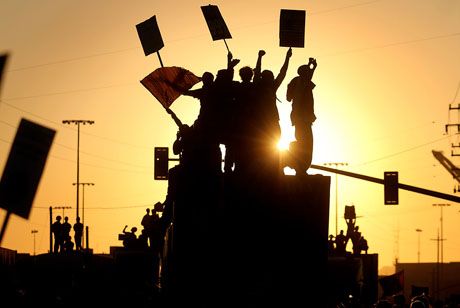Features
You are here
Legislation and illegal strikes

March 14, 2012
The following originally appeared on the blog Staffroom Confidential, written by BC teacher and activist Tara Ehrcke, President of the Greater Victoria Teachers’ Association.
Should teachers take action in response to Bill 22? Should they walk out regardless of the question of ‘legality’?
It now looks almost certain that even with School Boards, the public and parents in favour of a fair, independent, mediated settlement, the government is not yet prepared to change course on Bill 22, legislation that aims to repeal rights to due process, job protection, and professional autonomy, as well as the removal of class size limits and the right to bargain class size limits for another two years.
If Canadian workers never took illegal action, we would be a very different country indeed. In fact, the right to strike itself was won through illegal strikes. Here are a few legislative changes that resulted from strikes, many of which were not ‘legal’:
1872 – The Trade Union Act, making unions legal, is a response to the Toronto Printer’s strike for a 54 hour week.
1944 – Privy Council Order 1003 provides rights to collective bargaining based on the US Wagner Act in response to a series of war time strikes at Kirkland Lake and elsewhere.
1945 – The Rand formula, providing automatic union membership and dues collection, is a result of the Ford Windsor strike.
1965 – Canadian Parliament grants right to strike for some public sector workers in response to an illegal strike by the Canadian Union of Postal Workers.
1976 – Wage controls of the federal government are defeated after the first national Day of Protest involving workers across Canada.
Our own history is similarly one in which there have been as many ‘illegal’ actions than legal ones.
1919 – First teachers strike in Victoria, BC over wages, results in a negotiated settlement.
1921 – New Westminster teachers strike to win enforcement of an arbitration award on salaries.
1937 – Teachers in New Westminster defy School Board over firings and Board is ousted by province.
1971 – First province wide teacher strike in BC to secure pension improvements.
1974 – Strike by Surrey teachers wins improvement in pupil-teacher ratio.
1981 – Terrace teachers walk out to secure guaranteed personnel practices.
1983 – Teachers and other workers strike to defeat Bill 3 which would allow dismissal without cause.
1987 – For the first time, it becomes legal for teachers to strike. This lasts until 2002, with the introduction of “Essential Services” legislation.
2005 – Teachers walk out after being legislated back to work. After two weeks, Vince Ready is appointed as a mediator and an agreement is reached which is accepted by both sides.
Now more than ever, with governments aggressively trying to end protections for workers such as due process and seniority, we will need to make difficult decisions about taking action. What we know for certain is that when we don’t act, these same governments will feel confident to make further incursions on these rights. Since the 1990′s, the decline of strikes and unionization rates has allowed employers (both public sector and private) to erode both job protection rights as well as salaries. As a result, incomes have stagnated and purchasing power has fallen.
Teachers, just like other workers, have one tool that is effective in creating sufficient pressure to force good faith negotiation – the withdrawal of services.
Section:
- Log in to post comments










